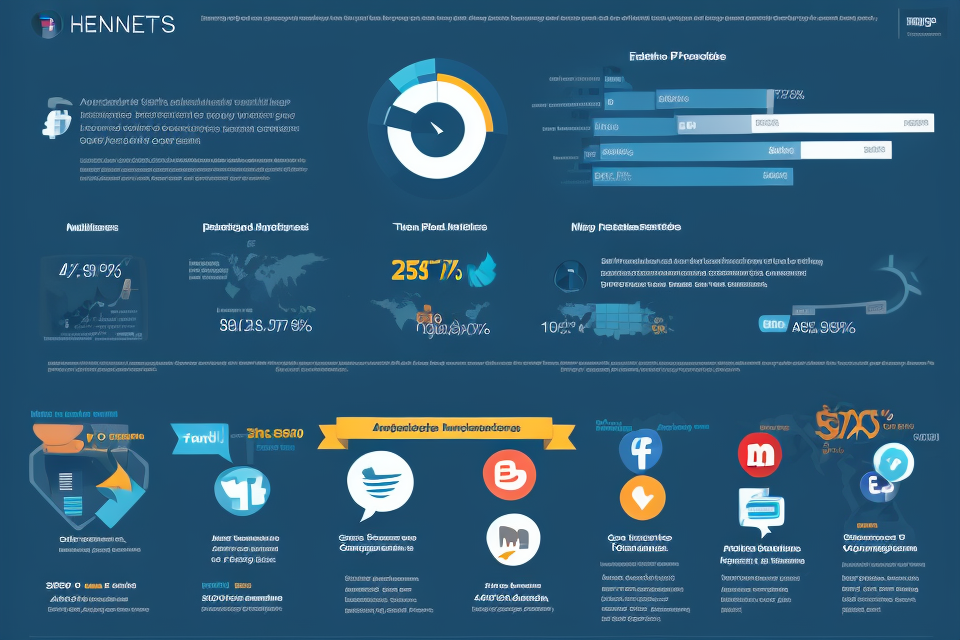Social media has become an integral part of modern business, and selecting the right platform is crucial for reaching your target audience. With numerous social media platforms available, determining the most active one for your business can be a daunting task. However, by understanding the demographics, interests, and behaviors of your target audience, you can make an informed decision and maximize your social media reach. In this article, we will explore the most active social media platforms and provide insights on how to choose the best one for your business. So, let’s dive in and discover the secrets to unlocking the full potential of social media for your business.
The most active social media platform for your business depends on your target audience and the type of business you have. However, as of 2021, Facebook remains the most popular social media platform with over 2.7 billion monthly active users. It’s a great platform for businesses to reach a wide range of demographics and connect with customers. Instagram, which is owned by Facebook, is also a popular platform for businesses, particularly those in the retail and fashion industries. Instagram has over 1 billion monthly active users and is a great platform for visual businesses to showcase their products and services through images and videos. Twitter is another popular platform for businesses, particularly those in the news and entertainment industries. It has over 330 million monthly active users and is a great platform for real-time updates and engagement with customers. Ultimately, the most active social media platform for your business will depend on your specific goals and target audience.
Identifying the Most Active Social Media Platform
Understanding Your Target Audience
Researching demographics
Researching demographics is an essential part of understanding your target audience. This involves analyzing the age, gender, location, and other demographic factors of your potential customers. By doing so, you can identify which social media platforms are most popular among your target audience.
For example, if your target audience is primarily young adults, you may want to focus on platforms like TikTok and Instagram, which are popular among this age group. On the other hand, if your target audience is primarily older adults, you may want to focus on platforms like Facebook and LinkedIn, which are more popular among this age group.
Analyzing interests and behaviors
In addition to demographics, it’s also important to analyze the interests and behaviors of your target audience. This can help you identify which social media platforms are most relevant to your business.
For example, if your target audience is interested in fashion, you may want to focus on platforms like Instagram and Pinterest, which are popular among fashion enthusiasts. If your target audience is interested in technology, you may want to focus on platforms like Twitter and Reddit, which are popular among tech enthusiasts.
Creating audience personas
Creating audience personas is another effective way to understand your target audience. This involves creating fictional representations of your ideal customers, based on their demographics, interests, and behaviors. By doing so, you can get a better understanding of who your customers are and what they care about, which can help you identify the most effective social media platforms for your business.
For example, if your audience persona is a young professional in their 30s who is interested in health and wellness, you may want to focus on platforms like Instagram and Facebook, which are popular among this demographic. By tailoring your social media strategy to your audience personas, you can increase the effectiveness of your marketing efforts and reach your target audience more effectively.
Evaluating Engagement Metrics
When it comes to identifying the most active social media platform for your business, evaluating engagement metrics is crucial. Engagement metrics help you determine how well your content is resonating with your target audience. Here are some key engagement metrics to consider:
Follower Growth Rate
The follower growth rate is an important metric to track, as it can indicate the level of interest in your content. By analyzing the growth rate of your followers over time, you can identify which social media platforms are driving the most growth for your business. A high follower growth rate on a particular platform may suggest that it is a good fit for your marketing strategy.
Average Number of Likes, Comments, and Shares
The average number of likes, comments, and shares on your content can give you a sense of how engaged your audience is with your brand. Platforms that drive high levels of engagement may be more effective for building relationships with your customers and promoting your products or services. Additionally, engagement metrics can help you identify which types of content are resonating with your audience, so you can optimize your content strategy accordingly.
Click-Through Rates
Click-through rates (CTRs) measure the percentage of people who click on a link in your content. By tracking CTRs across different social media platforms, you can determine which platforms drive the most traffic to your website or other online channels. High CTRs may indicate that a particular platform is effective for driving conversions or generating leads.
User-Generated Content
User-generated content (UGC) can be a powerful way to build engagement and loyalty among your audience. By encouraging your followers to create and share content related to your brand, you can tap into the power of social proof and increase the visibility of your brand on social media. Platforms that drive high levels of UGC may be particularly effective for building community and fostering engagement with your audience.
Assessing Platform Features
When assessing the most active social media platform for your business, it’s important to consider several key features that can impact your ability to reach and engage with your target audience. These features include:
- Posting frequency: The frequency at which you can post content on a given platform can have a significant impact on your ability to engage with your audience. For example, platforms like Twitter and Instagram allow for frequent, real-time posting, while platforms like Facebook and LinkedIn have more restrictive posting schedules.
- Content format options: Different social media platforms offer different content format options, such as text, images, videos, and live streaming. Consider which formats are most appropriate for your business and which platforms offer the best options for those formats.
- Advertising opportunities: Depending on your business goals, you may want to consider advertising on social media platforms. Some platforms, like Facebook and Instagram, offer highly targeted advertising options, while others, like Twitter and LinkedIn, offer more broad-based advertising options.
- Integration with other tools: Many businesses use a variety of tools to manage their social media presence, such as scheduling tools, analytics tools, and content creation tools. Consider which platforms integrate best with the tools you already use, and which offer the most robust integrations.
Examining Platform Popularity
When it comes to identifying the most active social media platform for your business, examining platform popularity is a crucial step. This involves analyzing the market share, user base size, trending topics and hashtags, and competitor presence on each platform.
- Market Share: The market share of a social media platform refers to the percentage of the total online population that uses the platform. It is an important metric to consider as it indicates the overall reach and influence of the platform. For example, as of 2021, Facebook has the largest market share among all social media platforms, with over 2.7 billion monthly active users.
- User Base Size: The user base size of a social media platform refers to the number of registered users on the platform. While market share focuses on the percentage of the total online population, user base size focuses on the actual number of users. It is important to consider the size of the user base as it directly impacts the potential reach and engagement of your content.
- Trending Topics and Hashtags: The trending topics and hashtags on a social media platform can provide insight into what users are currently interested in and engaged with. By analyzing these trends, you can tailor your content to align with current interests and increase the chances of engagement and reach.
- Competitor Presence: The presence of your competitors on a social media platform can also impact the effectiveness of your business’s presence on that platform. It is important to consider the level of competition and how you can differentiate yourself from other businesses in your industry.
Overall, examining platform popularity can provide valuable insights into the potential reach and engagement of your business on a particular social media platform. By considering market share, user base size, trending topics and hashtags, and competitor presence, you can make an informed decision on which platform is best suited for your business.
Considering Business Goals
When identifying the most active social media platform for your business, it is important to consider your business goals. The platform you choose should align with your objectives and help you achieve them. Here are some of the key business goals that you should consider when selecting a social media platform:
Brand Awareness
If your primary goal is to increase brand awareness, then you should consider platforms that have a large user base and allow you to reach a broad audience. Platforms like Facebook and Instagram are great for this purpose as they have billions of active users. By creating engaging content and using targeted advertising, you can reach a large audience and increase your brand visibility.
Customer Engagement
If your goal is to engage with your customers and build a community around your brand, then you should consider platforms that allow for two-way communication. Platforms like Twitter and LinkedIn are great for this purpose as they allow you to interact with your followers in real-time. By sharing valuable content and responding to customer inquiries, you can build a strong relationship with your audience.
Lead Generation
If your goal is to generate leads and attract potential customers, then you should consider platforms that allow you to target specific audiences. Platforms like LinkedIn and Twitter are great for this purpose as they allow you to use targeted advertising and lead generation tools. By creating lead magnets and optimizing your profile, you can attract potential customers and grow your business.
Sales Conversion
If your goal is to convert sales and drive revenue, then you should consider platforms that allow you to track conversions and optimize your sales funnel. Platforms like Facebook and Instagram are great for this purpose as they allow you to use tracking pixels and conversion tracking. By optimizing your ads and landing pages, you can increase your conversion rates and drive more sales.
Overall, it is important to consider your business goals when selecting a social media platform. By aligning your goals with the right platform, you can increase your brand visibility, engage with your customers, generate leads, and drive revenue.
Choosing the Most Active Platform for Your Business
Balancing Reach and Engagement
When it comes to choosing the most active social media platform for your business, it’s important to balance reach and engagement. Here are some key factors to consider:
- Finding the right audience: Different social media platforms have different demographics, so it’s important to choose the one that aligns with your target audience. For example, Instagram is popular among millennials and Gen Z, while LinkedIn is more popular among professionals and businesses.
- Maximizing audience interaction: While reach is important, engagement is equally important. It’s essential to choose a platform that allows you to interact with your audience in a meaningful way. For example, Twitter is a great platform for real-time engagement, while Facebook is better for building relationships with customers.
- Identifying platform-specific opportunities: Each social media platform has its own unique features and opportunities. For example, Instagram is great for visual content, while LinkedIn is ideal for sharing industry news and thought leadership articles.
Overall, the key to choosing the most active social media platform for your business is to find the right balance between reach and engagement, and to identify the platform-specific opportunities that align with your business goals.
Evaluating Platform Strengths and Weaknesses
When it comes to choosing the most active social media platform for your business, it’s important to evaluate the strengths and weaknesses of each platform. This will help you determine which platform is the best fit for your business goals and target audience. Here are some factors to consider when evaluating the strengths and weaknesses of each platform:
Comparing Platform Features
One of the first things to consider when evaluating social media platforms is their features. Each platform has its own unique set of features that can be used to achieve different marketing goals. For example, Instagram is known for its visual content, while Twitter is great for real-time engagement with your audience.
It’s important to compare the features of each platform to determine which one is the best fit for your business goals. Consider which platform has the features that align with your marketing strategy and will help you achieve your desired outcomes.
Analyzing Success Stories and Case Studies
Another way to evaluate the strengths and weaknesses of each platform is by analyzing success stories and case studies. Look at how other businesses have used each platform to achieve their marketing goals. This can give you an idea of what works and what doesn’t on each platform.
For example, if you’re considering using Instagram for your business, look at how other businesses in your industry have used the platform to engage with their audience and drive sales. This can give you inspiration and ideas for your own Instagram strategy.
Assessing Platform Limitations
It’s also important to assess the limitations of each platform. Each platform has its own unique limitations that can impact your ability to achieve your marketing goals. For example, Instagram has limitations on the type of links you can include in your posts, which can impact your ability to drive traffic to your website.
By assessing the limitations of each platform, you can determine which one is the best fit for your business goals and target audience. Consider which platform will allow you to achieve your desired outcomes while also working within the limitations of the platform.
Creating a Comprehensive Social Media Strategy
In order to make the most out of your social media presence, it is crucial to have a well-defined strategy in place. A comprehensive social media strategy should encompass the following key elements:
- Setting SMART goals: Specific, Measurable, Achievable, Relevant, and Time-bound objectives. This ensures that your social media efforts are focused, and you have a clear idea of what you want to achieve. For instance, you might aim to increase brand awareness by a certain percentage within a specific time frame, or to boost sales through social media by a particular amount.
- Developing a content calendar: This helps you plan and organize your social media content in advance. By creating a content calendar, you can ensure that your posts are timely, relevant, and engaging. You can also identify the best days and times to post to maximize engagement.
- Allocating resources and budget: Social media marketing requires resources, both in terms of time and money. It is important to allocate the necessary resources to create high-quality content, engage with your audience, and run targeted advertising campaigns. You should also consider hiring a social media manager or an agency to help you manage your social media presence effectively.
- Measuring and adjusting performance: To evaluate the success of your social media strategy, you need to track key performance indicators (KPIs) such as follower growth, engagement rates, click-through rates, and conversions. Regularly monitoring these metrics will help you identify areas of improvement and make data-driven decisions to optimize your social media marketing efforts. It is important to adjust your strategy based on the insights you gather to ensure that you are continually making progress towards your goals.
Adapting to Changes in the Social Media Landscape
Staying Up-to-Date with Platform Algorithms
In today’s fast-paced digital landscape, it’s essential for businesses to stay up-to-date with platform algorithms if they want to succeed on social media. Understanding how algorithms work and monitoring algorithm updates can help businesses adjust their content strategy as needed to reach their target audience effectively. Here are some tips for staying up-to-date with platform algorithms:
Understanding how algorithms work
Algorithms are the backbone of social media platforms. They determine what content appears on users’ newsfeeds and how it’s ranked. Each platform has its unique algorithm, which takes into account various factors such as engagement, relevance, and timeliness. By understanding how algorithms work, businesses can create content that is more likely to be seen by their target audience.
Monitoring algorithm updates
Social media platforms are constantly updating their algorithms to improve user experience and keep up with changing trends. Keeping track of these updates is crucial for businesses to stay ahead of the curve. Platforms like Facebook and Instagram provide updates on their algorithms through blog posts, news releases, and even live Q&A sessions. It’s essential to stay informed about these updates to adjust content strategies accordingly.
Adjusting content strategy as needed
Algorithm updates can have a significant impact on a business’s social media presence. If a platform’s algorithm changes, businesses may need to adjust their content strategy to ensure their content continues to reach their target audience. For example, if a platform prioritizes video content over written content, businesses may need to invest more in video production. By monitoring algorithm updates and adjusting content strategies accordingly, businesses can stay ahead of the curve and continue to succeed on social media.
Responding to Platform Policy Changes
Platform policies are constantly evolving, and it is essential for businesses to keep up with these changes to maintain an effective social media presence. Here are some strategies for responding to platform policy changes:
- Keeping up with platform policies: It is crucial to stay informed about platform policies and updates. Follow the platform’s official blog, social media accounts, and announcements to stay up-to-date on any changes.
- Adapting content to platform guidelines: When platform policies change, businesses need to adjust their content accordingly. For example, if a platform changes its algorithm, businesses may need to alter their content strategy to ensure their posts are seen by their target audience.
- Preparing for potential platform changes: It is also essential to be prepared for potential platform changes. This includes developing a contingency plan for different scenarios, such as platform policy changes or even platform shutdowns.
Overall, responding to platform policy changes requires a proactive approach to social media management. By staying informed, adapting content, and preparing for potential changes, businesses can ensure that their social media presence remains effective and engaging.
Exploring Emerging Platforms and Features
- As the social media landscape continues to evolve, it’s crucial for businesses to stay informed about emerging platforms and features.
- By exploring new platforms and features, businesses can potentially reach new audiences and expand their online presence.
- Some examples of emerging social media platforms include TikTok, Clubhouse, and Instagram Reels.
- These platforms offer unique opportunities for businesses to showcase their products or services in creative and engaging ways.
- However, it’s important to carefully assess the relevance of these platforms to your business and target audience before investing time and resources into them.
- Experimenting with new features and strategies on established platforms like Facebook and Twitter can also help businesses stay ahead of the curve and attract new followers.
- For instance, using Instagram Stories and IGTV can provide businesses with additional opportunities to share visual content and connect with their audience.
- It’s important to regularly monitor and analyze the performance of your social media presence on various platforms to determine which ones are most effective for your business.
- By staying informed about emerging platforms and features, businesses can make informed decisions about where to focus their social media efforts and maximize their online reach.
FAQs
1. What is the most active social media platform?
Answer: It’s difficult to determine the most active social media platform as it can vary depending on your target audience, industry, and geographic location. However, as of 2021, the most popular social media platforms are Facebook, Instagram, Twitter, LinkedIn, and YouTube.
2. How do I choose the right social media platform for my business?
Answer: To choose the right social media platform for your business, you should consider your target audience, the type of content you want to share, and the goals you want to achieve. For example, if you’re targeting a younger demographic, Instagram and TikTok may be better suited for your business. If you’re looking to connect with other professionals in your industry, LinkedIn may be the best platform for you.
3. Can I use multiple social media platforms for my business?
Answer: Yes, you can use multiple social media platforms for your business. In fact, it’s often recommended to have a presence on multiple platforms to reach a wider audience. However, it’s important to keep in mind that managing multiple social media accounts can be time-consuming, so you’ll need to create a content strategy and schedule to ensure you’re consistently posting content across all platforms.
4. Is it necessary for my business to be on all social media platforms?
Answer: No, it’s not necessary for your business to be on all social media platforms. It’s important to focus on the platforms that align with your target audience and business goals. It’s better to have a strong presence on a few platforms rather than a weak presence on many.
5. How often should I post on social media for my business?
Answer: The frequency of posting on social media for your business depends on the platform and your target audience. As a general rule, it’s recommended to post at least once a day on Facebook and Instagram, and several times a day on Twitter. However, it’s important to remember that quality content is more important than quantity, so it’s better to post less frequently but with high-quality content.



